H&M Strategy Analysis: Competitive Advantage and Innovation
VerifiedAdded on 2022/08/16
|15
|4201
|19
Report
AI Summary
This report offers a comprehensive analysis of H&M's strategic positioning within the highly competitive fashion industry. It delves into the company's competitive advantages, examining theories such as Porter's generic strategies (cost leadership), the resource-based view, and dynamic capabilities to understand how H&M achieves its market success. The report explores H&M's marketing strategies, including its fast-fashion model, online presence, and customer interaction policies, highlighting the importance of innovation and internationalization in its profitable performance. The analysis also examines the company's key resources, such as design, marketing, supply chain, and employee management, and how these contribute to its ability to offer fashionable clothing at reasonable prices. The report concludes with a discussion on the company's strategic positioning and its ability to sustain competitive advantages in a rapidly evolving industry.
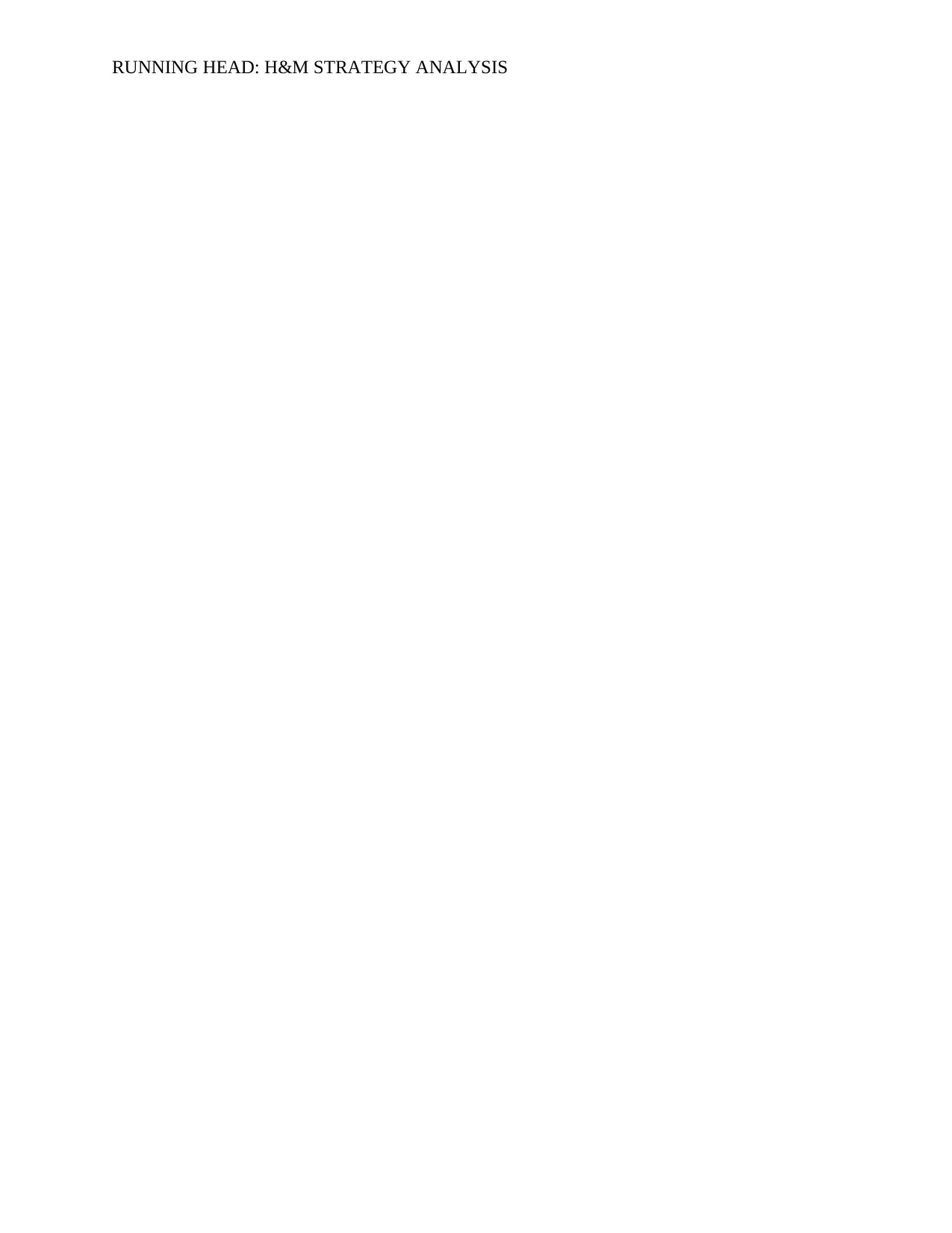
RUNNING HEAD: H&M STRATEGY ANALYSIS
Paraphrase This Document
Need a fresh take? Get an instant paraphrase of this document with our AI Paraphraser
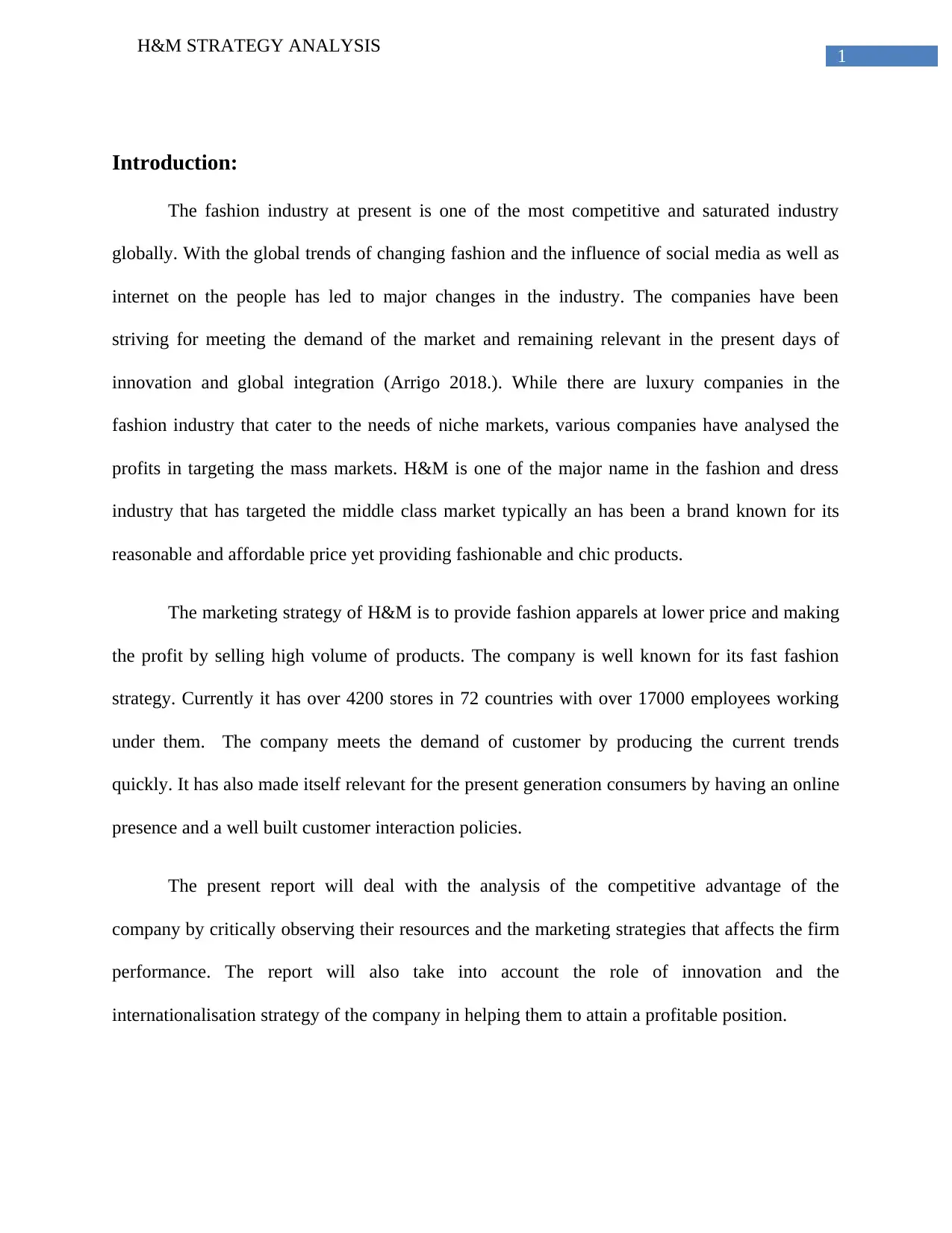
1
H&M STRATEGY ANALYSIS
Introduction:
The fashion industry at present is one of the most competitive and saturated industry
globally. With the global trends of changing fashion and the influence of social media as well as
internet on the people has led to major changes in the industry. The companies have been
striving for meeting the demand of the market and remaining relevant in the present days of
innovation and global integration (Arrigo 2018.). While there are luxury companies in the
fashion industry that cater to the needs of niche markets, various companies have analysed the
profits in targeting the mass markets. H&M is one of the major name in the fashion and dress
industry that has targeted the middle class market typically an has been a brand known for its
reasonable and affordable price yet providing fashionable and chic products.
The marketing strategy of H&M is to provide fashion apparels at lower price and making
the profit by selling high volume of products. The company is well known for its fast fashion
strategy. Currently it has over 4200 stores in 72 countries with over 17000 employees working
under them. The company meets the demand of customer by producing the current trends
quickly. It has also made itself relevant for the present generation consumers by having an online
presence and a well built customer interaction policies.
The present report will deal with the analysis of the competitive advantage of the
company by critically observing their resources and the marketing strategies that affects the firm
performance. The report will also take into account the role of innovation and the
internationalisation strategy of the company in helping them to attain a profitable position.
H&M STRATEGY ANALYSIS
Introduction:
The fashion industry at present is one of the most competitive and saturated industry
globally. With the global trends of changing fashion and the influence of social media as well as
internet on the people has led to major changes in the industry. The companies have been
striving for meeting the demand of the market and remaining relevant in the present days of
innovation and global integration (Arrigo 2018.). While there are luxury companies in the
fashion industry that cater to the needs of niche markets, various companies have analysed the
profits in targeting the mass markets. H&M is one of the major name in the fashion and dress
industry that has targeted the middle class market typically an has been a brand known for its
reasonable and affordable price yet providing fashionable and chic products.
The marketing strategy of H&M is to provide fashion apparels at lower price and making
the profit by selling high volume of products. The company is well known for its fast fashion
strategy. Currently it has over 4200 stores in 72 countries with over 17000 employees working
under them. The company meets the demand of customer by producing the current trends
quickly. It has also made itself relevant for the present generation consumers by having an online
presence and a well built customer interaction policies.
The present report will deal with the analysis of the competitive advantage of the
company by critically observing their resources and the marketing strategies that affects the firm
performance. The report will also take into account the role of innovation and the
internationalisation strategy of the company in helping them to attain a profitable position.
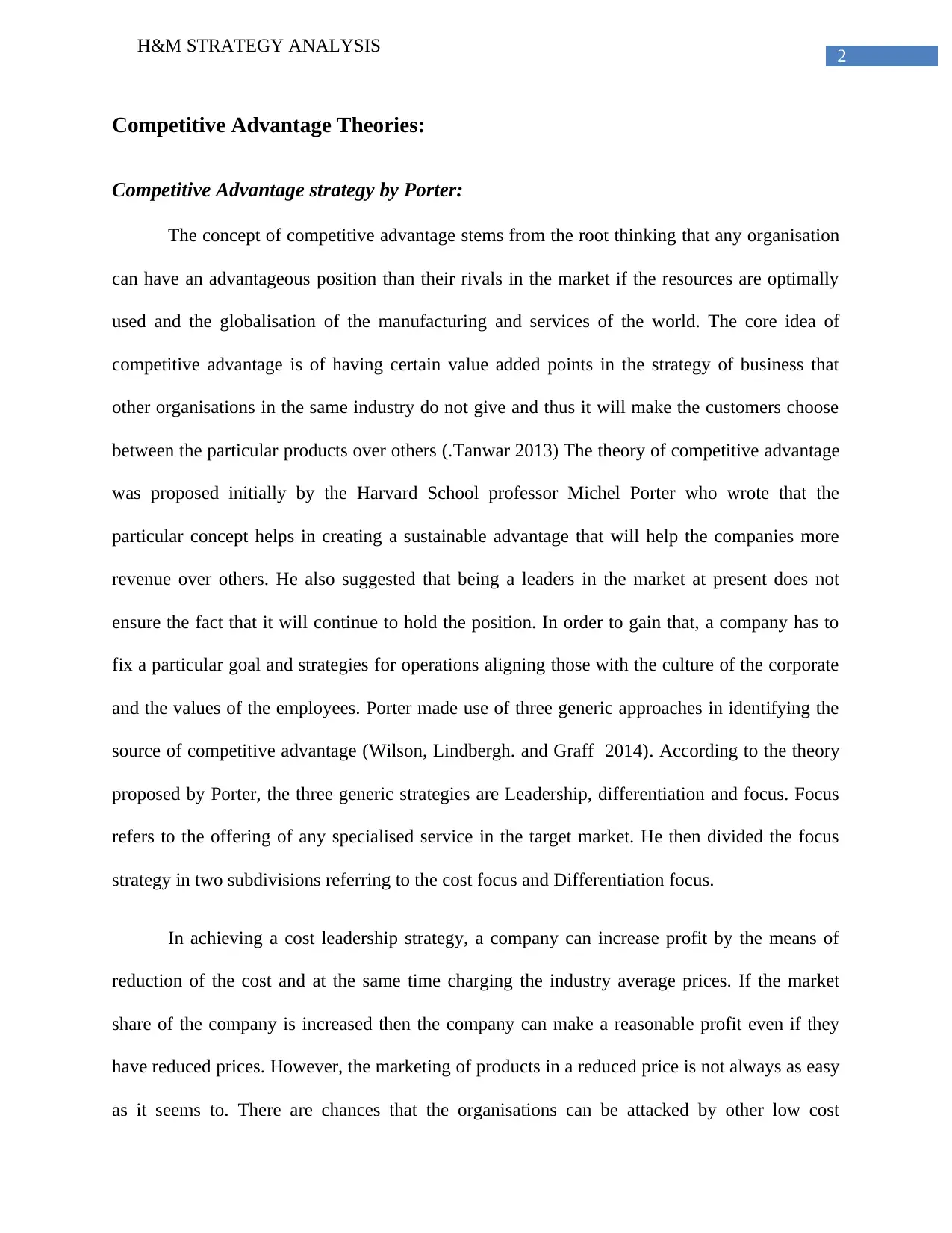
2
H&M STRATEGY ANALYSIS
Competitive Advantage Theories:
Competitive Advantage strategy by Porter:
The concept of competitive advantage stems from the root thinking that any organisation
can have an advantageous position than their rivals in the market if the resources are optimally
used and the globalisation of the manufacturing and services of the world. The core idea of
competitive advantage is of having certain value added points in the strategy of business that
other organisations in the same industry do not give and thus it will make the customers choose
between the particular products over others (.Tanwar 2013) The theory of competitive advantage
was proposed initially by the Harvard School professor Michel Porter who wrote that the
particular concept helps in creating a sustainable advantage that will help the companies more
revenue over others. He also suggested that being a leaders in the market at present does not
ensure the fact that it will continue to hold the position. In order to gain that, a company has to
fix a particular goal and strategies for operations aligning those with the culture of the corporate
and the values of the employees. Porter made use of three generic approaches in identifying the
source of competitive advantage (Wilson, Lindbergh. and Graff 2014). According to the theory
proposed by Porter, the three generic strategies are Leadership, differentiation and focus. Focus
refers to the offering of any specialised service in the target market. He then divided the focus
strategy in two subdivisions referring to the cost focus and Differentiation focus.
In achieving a cost leadership strategy, a company can increase profit by the means of
reduction of the cost and at the same time charging the industry average prices. If the market
share of the company is increased then the company can make a reasonable profit even if they
have reduced prices. However, the marketing of products in a reduced price is not always as easy
as it seems to. There are chances that the organisations can be attacked by other low cost
H&M STRATEGY ANALYSIS
Competitive Advantage Theories:
Competitive Advantage strategy by Porter:
The concept of competitive advantage stems from the root thinking that any organisation
can have an advantageous position than their rivals in the market if the resources are optimally
used and the globalisation of the manufacturing and services of the world. The core idea of
competitive advantage is of having certain value added points in the strategy of business that
other organisations in the same industry do not give and thus it will make the customers choose
between the particular products over others (.Tanwar 2013) The theory of competitive advantage
was proposed initially by the Harvard School professor Michel Porter who wrote that the
particular concept helps in creating a sustainable advantage that will help the companies more
revenue over others. He also suggested that being a leaders in the market at present does not
ensure the fact that it will continue to hold the position. In order to gain that, a company has to
fix a particular goal and strategies for operations aligning those with the culture of the corporate
and the values of the employees. Porter made use of three generic approaches in identifying the
source of competitive advantage (Wilson, Lindbergh. and Graff 2014). According to the theory
proposed by Porter, the three generic strategies are Leadership, differentiation and focus. Focus
refers to the offering of any specialised service in the target market. He then divided the focus
strategy in two subdivisions referring to the cost focus and Differentiation focus.
In achieving a cost leadership strategy, a company can increase profit by the means of
reduction of the cost and at the same time charging the industry average prices. If the market
share of the company is increased then the company can make a reasonable profit even if they
have reduced prices. However, the marketing of products in a reduced price is not always as easy
as it seems to. There are chances that the organisations can be attacked by other low cost
⊘ This is a preview!⊘
Do you want full access?
Subscribe today to unlock all pages.

Trusted by 1+ million students worldwide
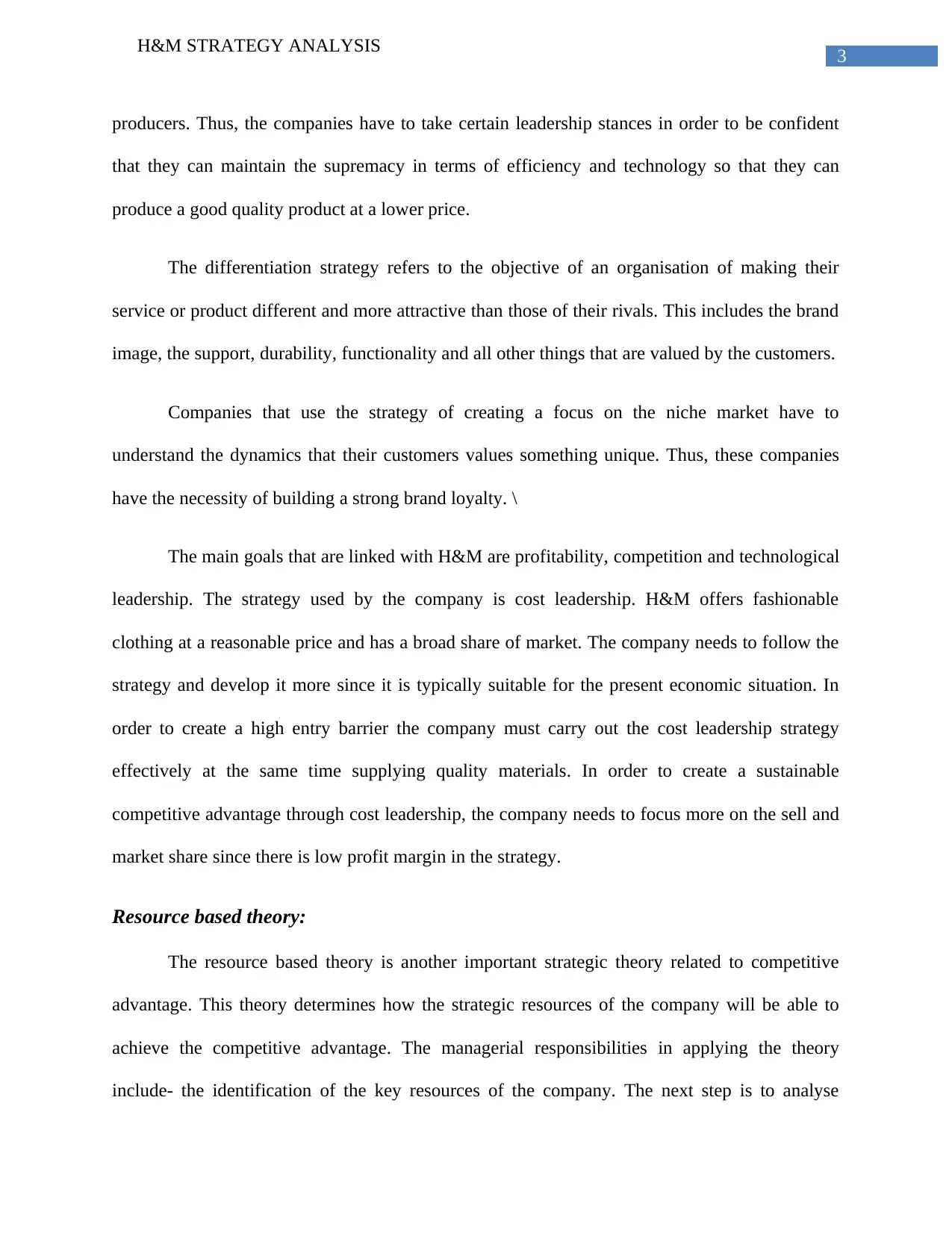
3
H&M STRATEGY ANALYSIS
producers. Thus, the companies have to take certain leadership stances in order to be confident
that they can maintain the supremacy in terms of efficiency and technology so that they can
produce a good quality product at a lower price.
The differentiation strategy refers to the objective of an organisation of making their
service or product different and more attractive than those of their rivals. This includes the brand
image, the support, durability, functionality and all other things that are valued by the customers.
Companies that use the strategy of creating a focus on the niche market have to
understand the dynamics that their customers values something unique. Thus, these companies
have the necessity of building a strong brand loyalty. \
The main goals that are linked with H&M are profitability, competition and technological
leadership. The strategy used by the company is cost leadership. H&M offers fashionable
clothing at a reasonable price and has a broad share of market. The company needs to follow the
strategy and develop it more since it is typically suitable for the present economic situation. In
order to create a high entry barrier the company must carry out the cost leadership strategy
effectively at the same time supplying quality materials. In order to create a sustainable
competitive advantage through cost leadership, the company needs to focus more on the sell and
market share since there is low profit margin in the strategy.
Resource based theory:
The resource based theory is another important strategic theory related to competitive
advantage. This theory determines how the strategic resources of the company will be able to
achieve the competitive advantage. The managerial responsibilities in applying the theory
include- the identification of the key resources of the company. The next step is to analyse
H&M STRATEGY ANALYSIS
producers. Thus, the companies have to take certain leadership stances in order to be confident
that they can maintain the supremacy in terms of efficiency and technology so that they can
produce a good quality product at a lower price.
The differentiation strategy refers to the objective of an organisation of making their
service or product different and more attractive than those of their rivals. This includes the brand
image, the support, durability, functionality and all other things that are valued by the customers.
Companies that use the strategy of creating a focus on the niche market have to
understand the dynamics that their customers values something unique. Thus, these companies
have the necessity of building a strong brand loyalty. \
The main goals that are linked with H&M are profitability, competition and technological
leadership. The strategy used by the company is cost leadership. H&M offers fashionable
clothing at a reasonable price and has a broad share of market. The company needs to follow the
strategy and develop it more since it is typically suitable for the present economic situation. In
order to create a high entry barrier the company must carry out the cost leadership strategy
effectively at the same time supplying quality materials. In order to create a sustainable
competitive advantage through cost leadership, the company needs to focus more on the sell and
market share since there is low profit margin in the strategy.
Resource based theory:
The resource based theory is another important strategic theory related to competitive
advantage. This theory determines how the strategic resources of the company will be able to
achieve the competitive advantage. The managerial responsibilities in applying the theory
include- the identification of the key resources of the company. The next step is to analyse
Paraphrase This Document
Need a fresh take? Get an instant paraphrase of this document with our AI Paraphraser
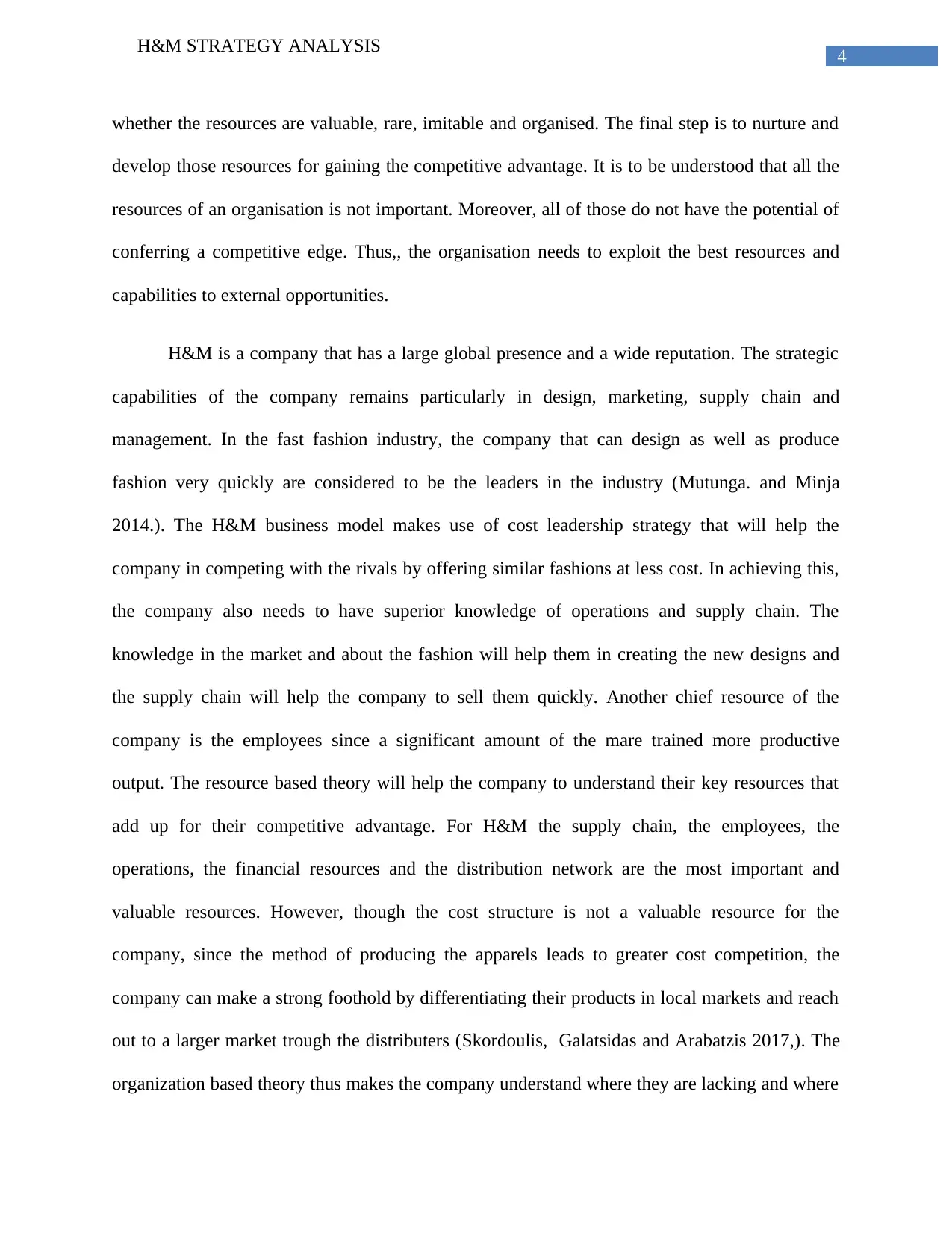
4
H&M STRATEGY ANALYSIS
whether the resources are valuable, rare, imitable and organised. The final step is to nurture and
develop those resources for gaining the competitive advantage. It is to be understood that all the
resources of an organisation is not important. Moreover, all of those do not have the potential of
conferring a competitive edge. Thus,, the organisation needs to exploit the best resources and
capabilities to external opportunities.
H&M is a company that has a large global presence and a wide reputation. The strategic
capabilities of the company remains particularly in design, marketing, supply chain and
management. In the fast fashion industry, the company that can design as well as produce
fashion very quickly are considered to be the leaders in the industry (Mutunga. and Minja
2014.). The H&M business model makes use of cost leadership strategy that will help the
company in competing with the rivals by offering similar fashions at less cost. In achieving this,
the company also needs to have superior knowledge of operations and supply chain. The
knowledge in the market and about the fashion will help them in creating the new designs and
the supply chain will help the company to sell them quickly. Another chief resource of the
company is the employees since a significant amount of the mare trained more productive
output. The resource based theory will help the company to understand their key resources that
add up for their competitive advantage. For H&M the supply chain, the employees, the
operations, the financial resources and the distribution network are the most important and
valuable resources. However, though the cost structure is not a valuable resource for the
company, since the method of producing the apparels leads to greater cost competition, the
company can make a strong foothold by differentiating their products in local markets and reach
out to a larger market trough the distributers (Skordoulis, Galatsidas and Arabatzis 2017,). The
organization based theory thus makes the company understand where they are lacking and where
H&M STRATEGY ANALYSIS
whether the resources are valuable, rare, imitable and organised. The final step is to nurture and
develop those resources for gaining the competitive advantage. It is to be understood that all the
resources of an organisation is not important. Moreover, all of those do not have the potential of
conferring a competitive edge. Thus,, the organisation needs to exploit the best resources and
capabilities to external opportunities.
H&M is a company that has a large global presence and a wide reputation. The strategic
capabilities of the company remains particularly in design, marketing, supply chain and
management. In the fast fashion industry, the company that can design as well as produce
fashion very quickly are considered to be the leaders in the industry (Mutunga. and Minja
2014.). The H&M business model makes use of cost leadership strategy that will help the
company in competing with the rivals by offering similar fashions at less cost. In achieving this,
the company also needs to have superior knowledge of operations and supply chain. The
knowledge in the market and about the fashion will help them in creating the new designs and
the supply chain will help the company to sell them quickly. Another chief resource of the
company is the employees since a significant amount of the mare trained more productive
output. The resource based theory will help the company to understand their key resources that
add up for their competitive advantage. For H&M the supply chain, the employees, the
operations, the financial resources and the distribution network are the most important and
valuable resources. However, though the cost structure is not a valuable resource for the
company, since the method of producing the apparels leads to greater cost competition, the
company can make a strong foothold by differentiating their products in local markets and reach
out to a larger market trough the distributers (Skordoulis, Galatsidas and Arabatzis 2017,). The
organization based theory thus makes the company understand where they are lacking and where
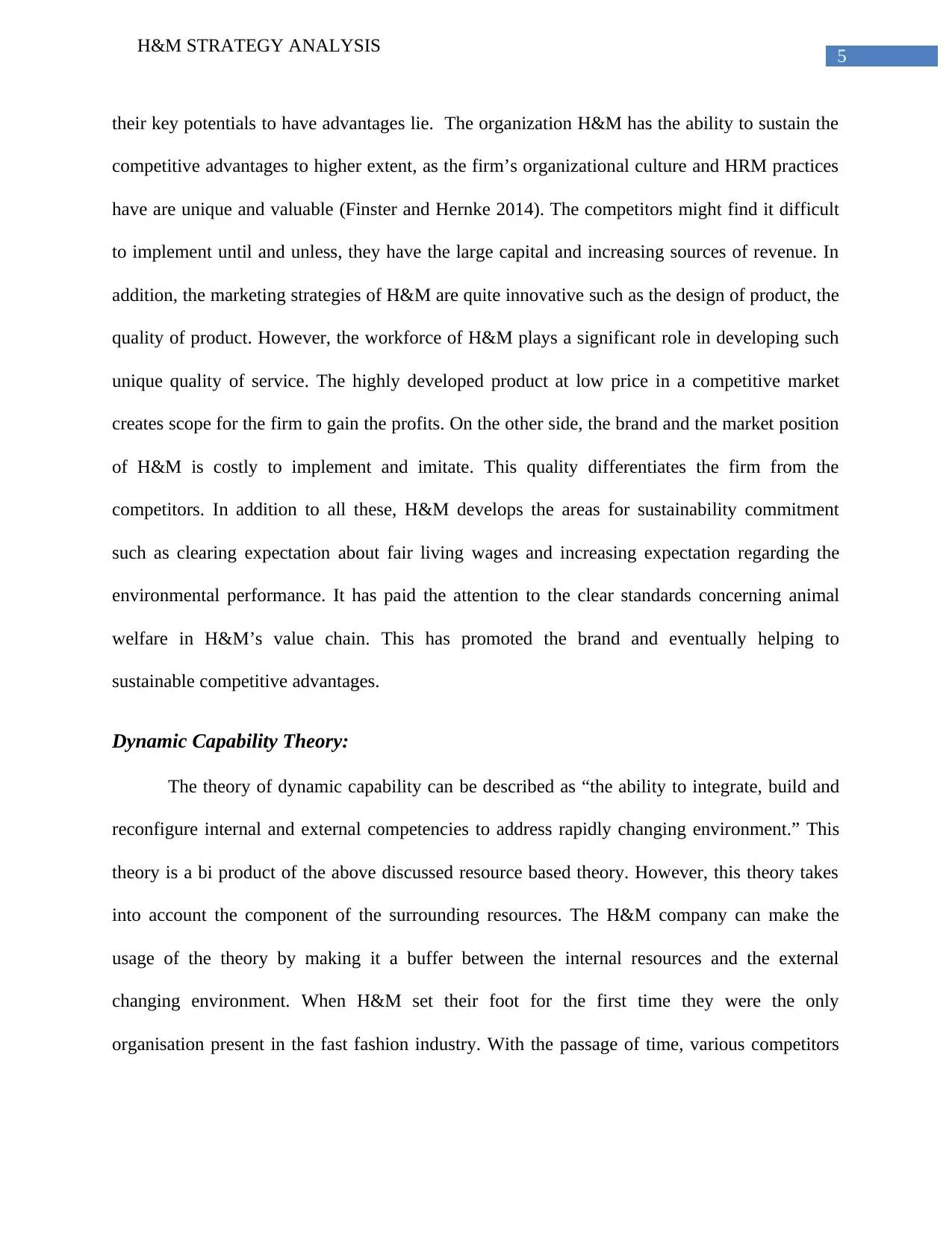
5
H&M STRATEGY ANALYSIS
their key potentials to have advantages lie. The organization H&M has the ability to sustain the
competitive advantages to higher extent, as the firm’s organizational culture and HRM practices
have are unique and valuable (Finster and Hernke 2014). The competitors might find it difficult
to implement until and unless, they have the large capital and increasing sources of revenue. In
addition, the marketing strategies of H&M are quite innovative such as the design of product, the
quality of product. However, the workforce of H&M plays a significant role in developing such
unique quality of service. The highly developed product at low price in a competitive market
creates scope for the firm to gain the profits. On the other side, the brand and the market position
of H&M is costly to implement and imitate. This quality differentiates the firm from the
competitors. In addition to all these, H&M develops the areas for sustainability commitment
such as clearing expectation about fair living wages and increasing expectation regarding the
environmental performance. It has paid the attention to the clear standards concerning animal
welfare in H&M’s value chain. This has promoted the brand and eventually helping to
sustainable competitive advantages.
Dynamic Capability Theory:
The theory of dynamic capability can be described as “the ability to integrate, build and
reconfigure internal and external competencies to address rapidly changing environment.” This
theory is a bi product of the above discussed resource based theory. However, this theory takes
into account the component of the surrounding resources. The H&M company can make the
usage of the theory by making it a buffer between the internal resources and the external
changing environment. When H&M set their foot for the first time they were the only
organisation present in the fast fashion industry. With the passage of time, various competitors
H&M STRATEGY ANALYSIS
their key potentials to have advantages lie. The organization H&M has the ability to sustain the
competitive advantages to higher extent, as the firm’s organizational culture and HRM practices
have are unique and valuable (Finster and Hernke 2014). The competitors might find it difficult
to implement until and unless, they have the large capital and increasing sources of revenue. In
addition, the marketing strategies of H&M are quite innovative such as the design of product, the
quality of product. However, the workforce of H&M plays a significant role in developing such
unique quality of service. The highly developed product at low price in a competitive market
creates scope for the firm to gain the profits. On the other side, the brand and the market position
of H&M is costly to implement and imitate. This quality differentiates the firm from the
competitors. In addition to all these, H&M develops the areas for sustainability commitment
such as clearing expectation about fair living wages and increasing expectation regarding the
environmental performance. It has paid the attention to the clear standards concerning animal
welfare in H&M’s value chain. This has promoted the brand and eventually helping to
sustainable competitive advantages.
Dynamic Capability Theory:
The theory of dynamic capability can be described as “the ability to integrate, build and
reconfigure internal and external competencies to address rapidly changing environment.” This
theory is a bi product of the above discussed resource based theory. However, this theory takes
into account the component of the surrounding resources. The H&M company can make the
usage of the theory by making it a buffer between the internal resources and the external
changing environment. When H&M set their foot for the first time they were the only
organisation present in the fast fashion industry. With the passage of time, various competitors
⊘ This is a preview!⊘
Do you want full access?
Subscribe today to unlock all pages.

Trusted by 1+ million students worldwide
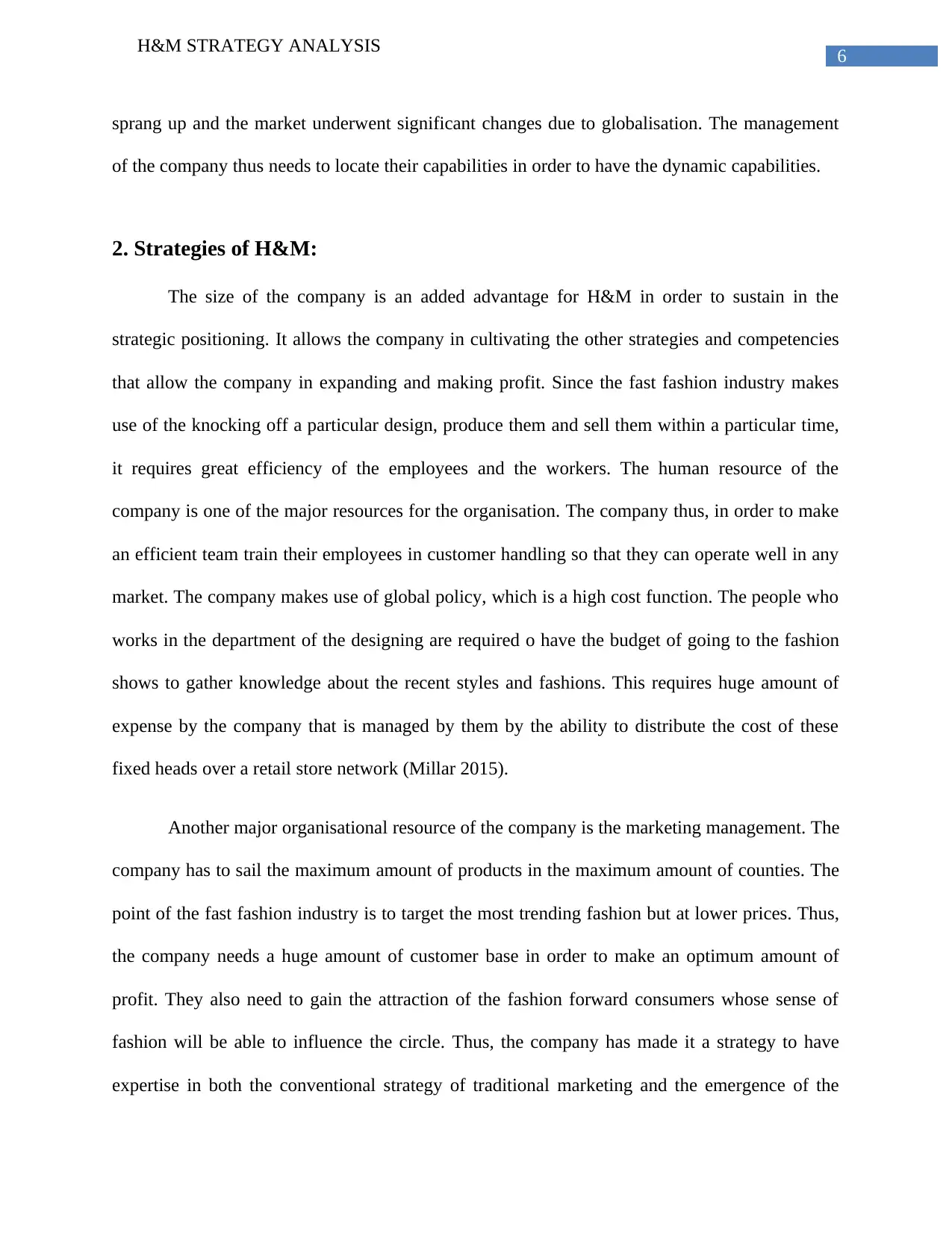
6
H&M STRATEGY ANALYSIS
sprang up and the market underwent significant changes due to globalisation. The management
of the company thus needs to locate their capabilities in order to have the dynamic capabilities.
2. Strategies of H&M:
The size of the company is an added advantage for H&M in order to sustain in the
strategic positioning. It allows the company in cultivating the other strategies and competencies
that allow the company in expanding and making profit. Since the fast fashion industry makes
use of the knocking off a particular design, produce them and sell them within a particular time,
it requires great efficiency of the employees and the workers. The human resource of the
company is one of the major resources for the organisation. The company thus, in order to make
an efficient team train their employees in customer handling so that they can operate well in any
market. The company makes use of global policy, which is a high cost function. The people who
works in the department of the designing are required o have the budget of going to the fashion
shows to gather knowledge about the recent styles and fashions. This requires huge amount of
expense by the company that is managed by them by the ability to distribute the cost of these
fixed heads over a retail store network (Millar 2015).
Another major organisational resource of the company is the marketing management. The
company has to sail the maximum amount of products in the maximum amount of counties. The
point of the fast fashion industry is to target the most trending fashion but at lower prices. Thus,
the company needs a huge amount of customer base in order to make an optimum amount of
profit. They also need to gain the attraction of the fashion forward consumers whose sense of
fashion will be able to influence the circle. Thus, the company has made it a strategy to have
expertise in both the conventional strategy of traditional marketing and the emergence of the
H&M STRATEGY ANALYSIS
sprang up and the market underwent significant changes due to globalisation. The management
of the company thus needs to locate their capabilities in order to have the dynamic capabilities.
2. Strategies of H&M:
The size of the company is an added advantage for H&M in order to sustain in the
strategic positioning. It allows the company in cultivating the other strategies and competencies
that allow the company in expanding and making profit. Since the fast fashion industry makes
use of the knocking off a particular design, produce them and sell them within a particular time,
it requires great efficiency of the employees and the workers. The human resource of the
company is one of the major resources for the organisation. The company thus, in order to make
an efficient team train their employees in customer handling so that they can operate well in any
market. The company makes use of global policy, which is a high cost function. The people who
works in the department of the designing are required o have the budget of going to the fashion
shows to gather knowledge about the recent styles and fashions. This requires huge amount of
expense by the company that is managed by them by the ability to distribute the cost of these
fixed heads over a retail store network (Millar 2015).
Another major organisational resource of the company is the marketing management. The
company has to sail the maximum amount of products in the maximum amount of counties. The
point of the fast fashion industry is to target the most trending fashion but at lower prices. Thus,
the company needs a huge amount of customer base in order to make an optimum amount of
profit. They also need to gain the attraction of the fashion forward consumers whose sense of
fashion will be able to influence the circle. Thus, the company has made it a strategy to have
expertise in both the conventional strategy of traditional marketing and the emergence of the
Paraphrase This Document
Need a fresh take? Get an instant paraphrase of this document with our AI Paraphraser
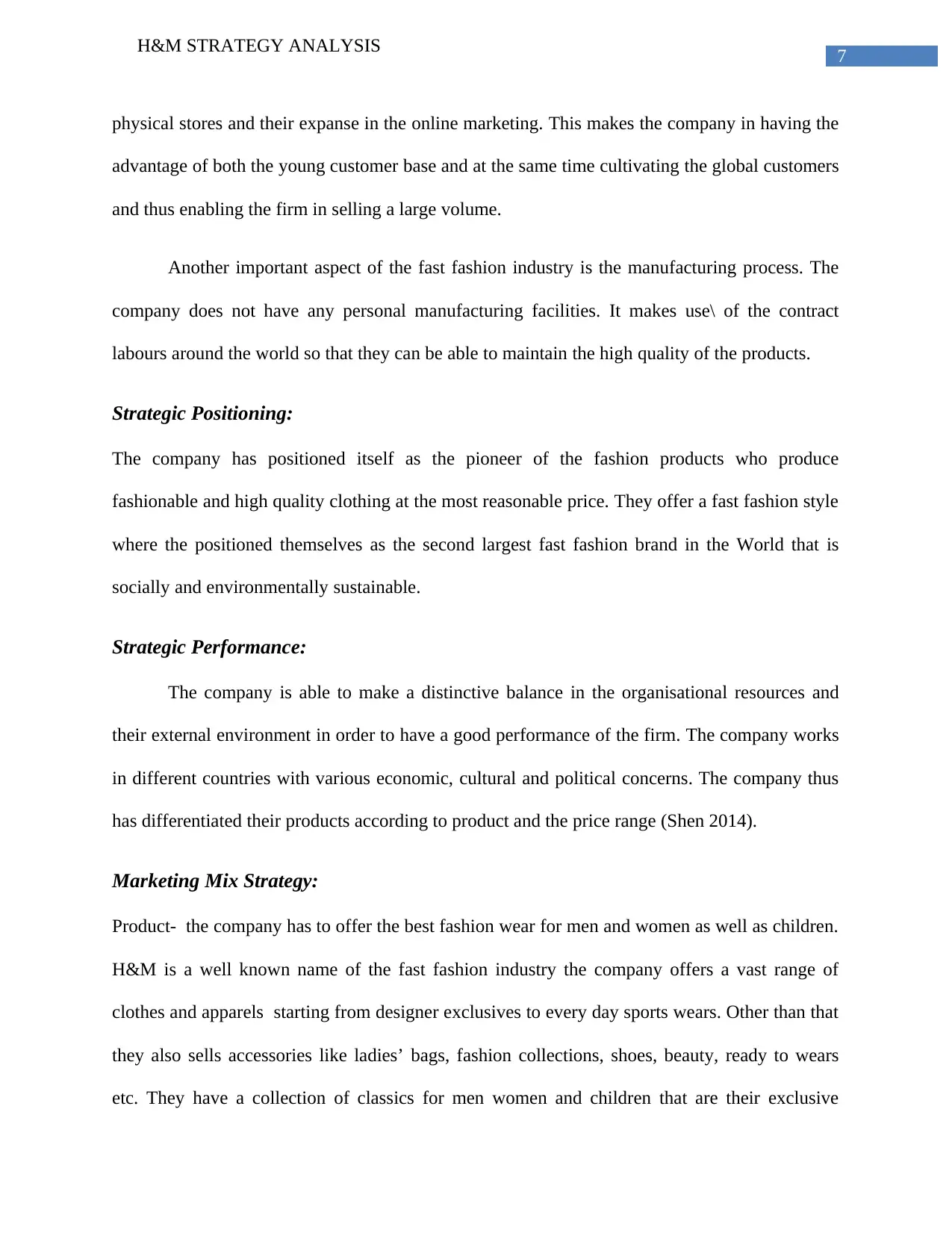
7
H&M STRATEGY ANALYSIS
physical stores and their expanse in the online marketing. This makes the company in having the
advantage of both the young customer base and at the same time cultivating the global customers
and thus enabling the firm in selling a large volume.
Another important aspect of the fast fashion industry is the manufacturing process. The
company does not have any personal manufacturing facilities. It makes use\ of the contract
labours around the world so that they can be able to maintain the high quality of the products.
Strategic Positioning:
The company has positioned itself as the pioneer of the fashion products who produce
fashionable and high quality clothing at the most reasonable price. They offer a fast fashion style
where the positioned themselves as the second largest fast fashion brand in the World that is
socially and environmentally sustainable.
Strategic Performance:
The company is able to make a distinctive balance in the organisational resources and
their external environment in order to have a good performance of the firm. The company works
in different countries with various economic, cultural and political concerns. The company thus
has differentiated their products according to product and the price range (Shen 2014).
Marketing Mix Strategy:
Product- the company has to offer the best fashion wear for men and women as well as children.
H&M is a well known name of the fast fashion industry the company offers a vast range of
clothes and apparels starting from designer exclusives to every day sports wears. Other than that
they also sells accessories like ladies’ bags, fashion collections, shoes, beauty, ready to wears
etc. They have a collection of classics for men women and children that are their exclusive
H&M STRATEGY ANALYSIS
physical stores and their expanse in the online marketing. This makes the company in having the
advantage of both the young customer base and at the same time cultivating the global customers
and thus enabling the firm in selling a large volume.
Another important aspect of the fast fashion industry is the manufacturing process. The
company does not have any personal manufacturing facilities. It makes use\ of the contract
labours around the world so that they can be able to maintain the high quality of the products.
Strategic Positioning:
The company has positioned itself as the pioneer of the fashion products who produce
fashionable and high quality clothing at the most reasonable price. They offer a fast fashion style
where the positioned themselves as the second largest fast fashion brand in the World that is
socially and environmentally sustainable.
Strategic Performance:
The company is able to make a distinctive balance in the organisational resources and
their external environment in order to have a good performance of the firm. The company works
in different countries with various economic, cultural and political concerns. The company thus
has differentiated their products according to product and the price range (Shen 2014).
Marketing Mix Strategy:
Product- the company has to offer the best fashion wear for men and women as well as children.
H&M is a well known name of the fast fashion industry the company offers a vast range of
clothes and apparels starting from designer exclusives to every day sports wears. Other than that
they also sells accessories like ladies’ bags, fashion collections, shoes, beauty, ready to wears
etc. They have a collection of classics for men women and children that are their exclusive
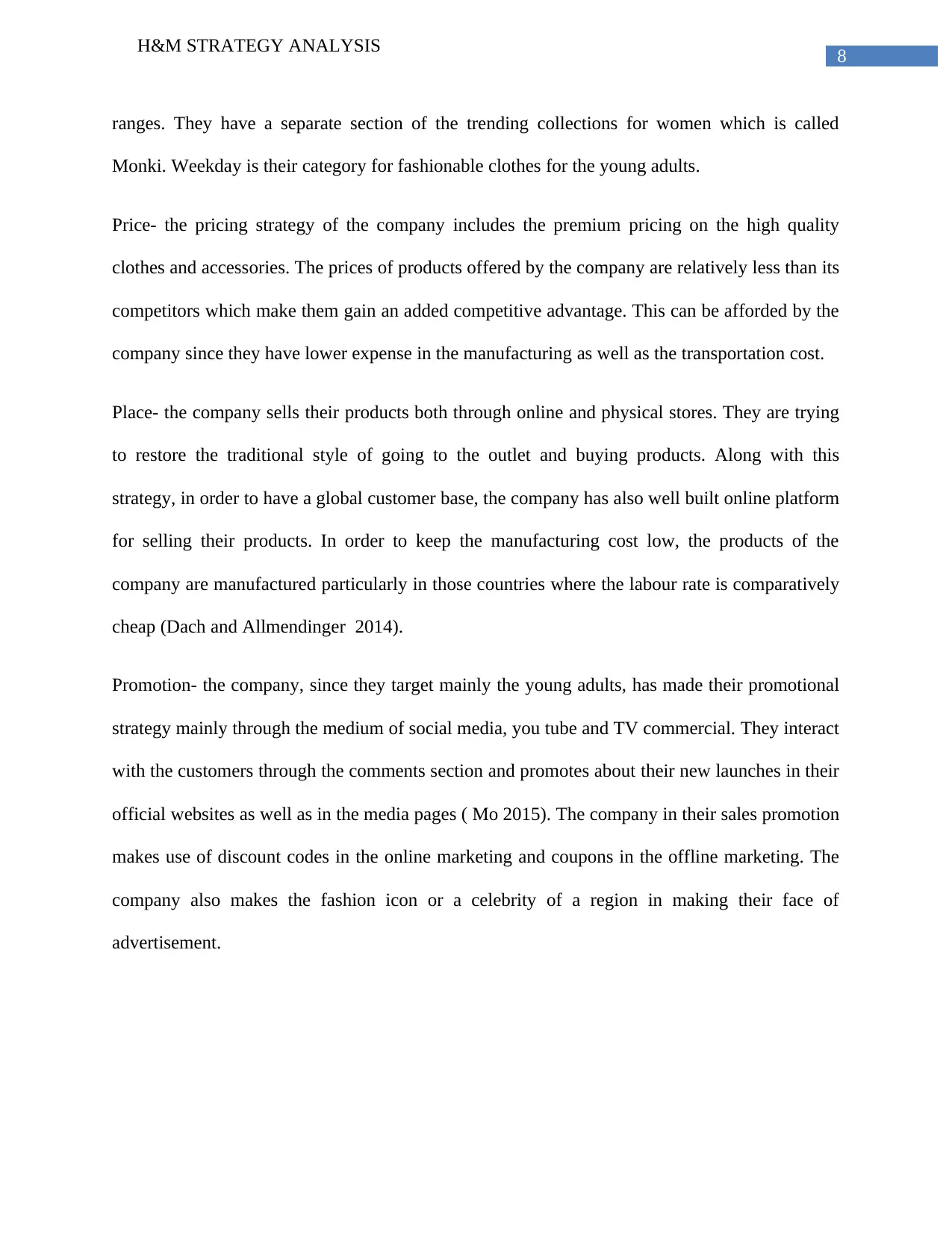
8
H&M STRATEGY ANALYSIS
ranges. They have a separate section of the trending collections for women which is called
Monki. Weekday is their category for fashionable clothes for the young adults.
Price- the pricing strategy of the company includes the premium pricing on the high quality
clothes and accessories. The prices of products offered by the company are relatively less than its
competitors which make them gain an added competitive advantage. This can be afforded by the
company since they have lower expense in the manufacturing as well as the transportation cost.
Place- the company sells their products both through online and physical stores. They are trying
to restore the traditional style of going to the outlet and buying products. Along with this
strategy, in order to have a global customer base, the company has also well built online platform
for selling their products. In order to keep the manufacturing cost low, the products of the
company are manufactured particularly in those countries where the labour rate is comparatively
cheap (Dach and Allmendinger 2014).
Promotion- the company, since they target mainly the young adults, has made their promotional
strategy mainly through the medium of social media, you tube and TV commercial. They interact
with the customers through the comments section and promotes about their new launches in their
official websites as well as in the media pages ( Mo 2015). The company in their sales promotion
makes use of discount codes in the online marketing and coupons in the offline marketing. The
company also makes the fashion icon or a celebrity of a region in making their face of
advertisement.
H&M STRATEGY ANALYSIS
ranges. They have a separate section of the trending collections for women which is called
Monki. Weekday is their category for fashionable clothes for the young adults.
Price- the pricing strategy of the company includes the premium pricing on the high quality
clothes and accessories. The prices of products offered by the company are relatively less than its
competitors which make them gain an added competitive advantage. This can be afforded by the
company since they have lower expense in the manufacturing as well as the transportation cost.
Place- the company sells their products both through online and physical stores. They are trying
to restore the traditional style of going to the outlet and buying products. Along with this
strategy, in order to have a global customer base, the company has also well built online platform
for selling their products. In order to keep the manufacturing cost low, the products of the
company are manufactured particularly in those countries where the labour rate is comparatively
cheap (Dach and Allmendinger 2014).
Promotion- the company, since they target mainly the young adults, has made their promotional
strategy mainly through the medium of social media, you tube and TV commercial. They interact
with the customers through the comments section and promotes about their new launches in their
official websites as well as in the media pages ( Mo 2015). The company in their sales promotion
makes use of discount codes in the online marketing and coupons in the offline marketing. The
company also makes the fashion icon or a celebrity of a region in making their face of
advertisement.
⊘ This is a preview!⊘
Do you want full access?
Subscribe today to unlock all pages.

Trusted by 1+ million students worldwide
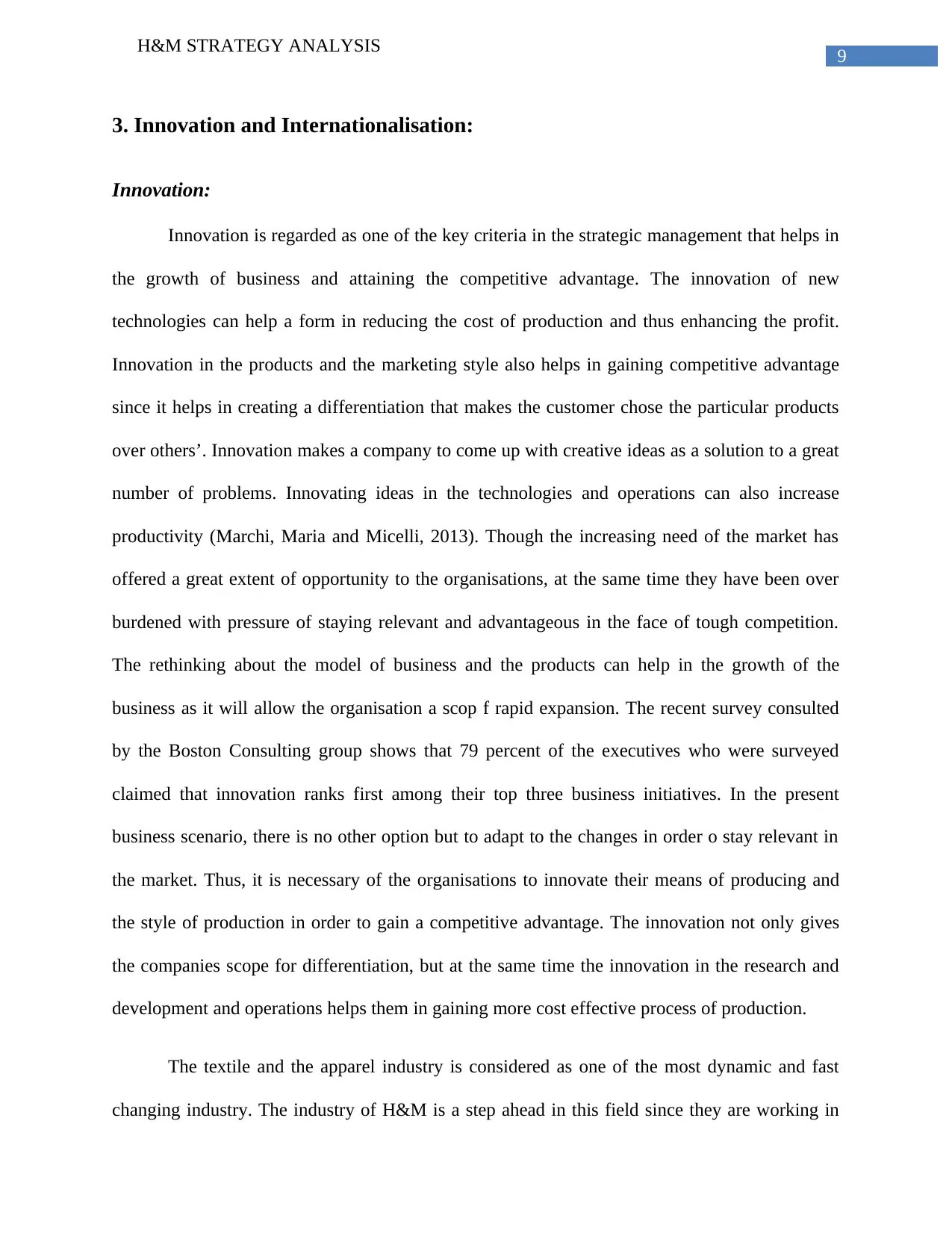
9
H&M STRATEGY ANALYSIS
3. Innovation and Internationalisation:
Innovation:
Innovation is regarded as one of the key criteria in the strategic management that helps in
the growth of business and attaining the competitive advantage. The innovation of new
technologies can help a form in reducing the cost of production and thus enhancing the profit.
Innovation in the products and the marketing style also helps in gaining competitive advantage
since it helps in creating a differentiation that makes the customer chose the particular products
over others’. Innovation makes a company to come up with creative ideas as a solution to a great
number of problems. Innovating ideas in the technologies and operations can also increase
productivity (Marchi, Maria and Micelli, 2013). Though the increasing need of the market has
offered a great extent of opportunity to the organisations, at the same time they have been over
burdened with pressure of staying relevant and advantageous in the face of tough competition.
The rethinking about the model of business and the products can help in the growth of the
business as it will allow the organisation a scop f rapid expansion. The recent survey consulted
by the Boston Consulting group shows that 79 percent of the executives who were surveyed
claimed that innovation ranks first among their top three business initiatives. In the present
business scenario, there is no other option but to adapt to the changes in order o stay relevant in
the market. Thus, it is necessary of the organisations to innovate their means of producing and
the style of production in order to gain a competitive advantage. The innovation not only gives
the companies scope for differentiation, but at the same time the innovation in the research and
development and operations helps them in gaining more cost effective process of production.
The textile and the apparel industry is considered as one of the most dynamic and fast
changing industry. The industry of H&M is a step ahead in this field since they are working in
H&M STRATEGY ANALYSIS
3. Innovation and Internationalisation:
Innovation:
Innovation is regarded as one of the key criteria in the strategic management that helps in
the growth of business and attaining the competitive advantage. The innovation of new
technologies can help a form in reducing the cost of production and thus enhancing the profit.
Innovation in the products and the marketing style also helps in gaining competitive advantage
since it helps in creating a differentiation that makes the customer chose the particular products
over others’. Innovation makes a company to come up with creative ideas as a solution to a great
number of problems. Innovating ideas in the technologies and operations can also increase
productivity (Marchi, Maria and Micelli, 2013). Though the increasing need of the market has
offered a great extent of opportunity to the organisations, at the same time they have been over
burdened with pressure of staying relevant and advantageous in the face of tough competition.
The rethinking about the model of business and the products can help in the growth of the
business as it will allow the organisation a scop f rapid expansion. The recent survey consulted
by the Boston Consulting group shows that 79 percent of the executives who were surveyed
claimed that innovation ranks first among their top three business initiatives. In the present
business scenario, there is no other option but to adapt to the changes in order o stay relevant in
the market. Thus, it is necessary of the organisations to innovate their means of producing and
the style of production in order to gain a competitive advantage. The innovation not only gives
the companies scope for differentiation, but at the same time the innovation in the research and
development and operations helps them in gaining more cost effective process of production.
The textile and the apparel industry is considered as one of the most dynamic and fast
changing industry. The industry of H&M is a step ahead in this field since they are working in
Paraphrase This Document
Need a fresh take? Get an instant paraphrase of this document with our AI Paraphraser
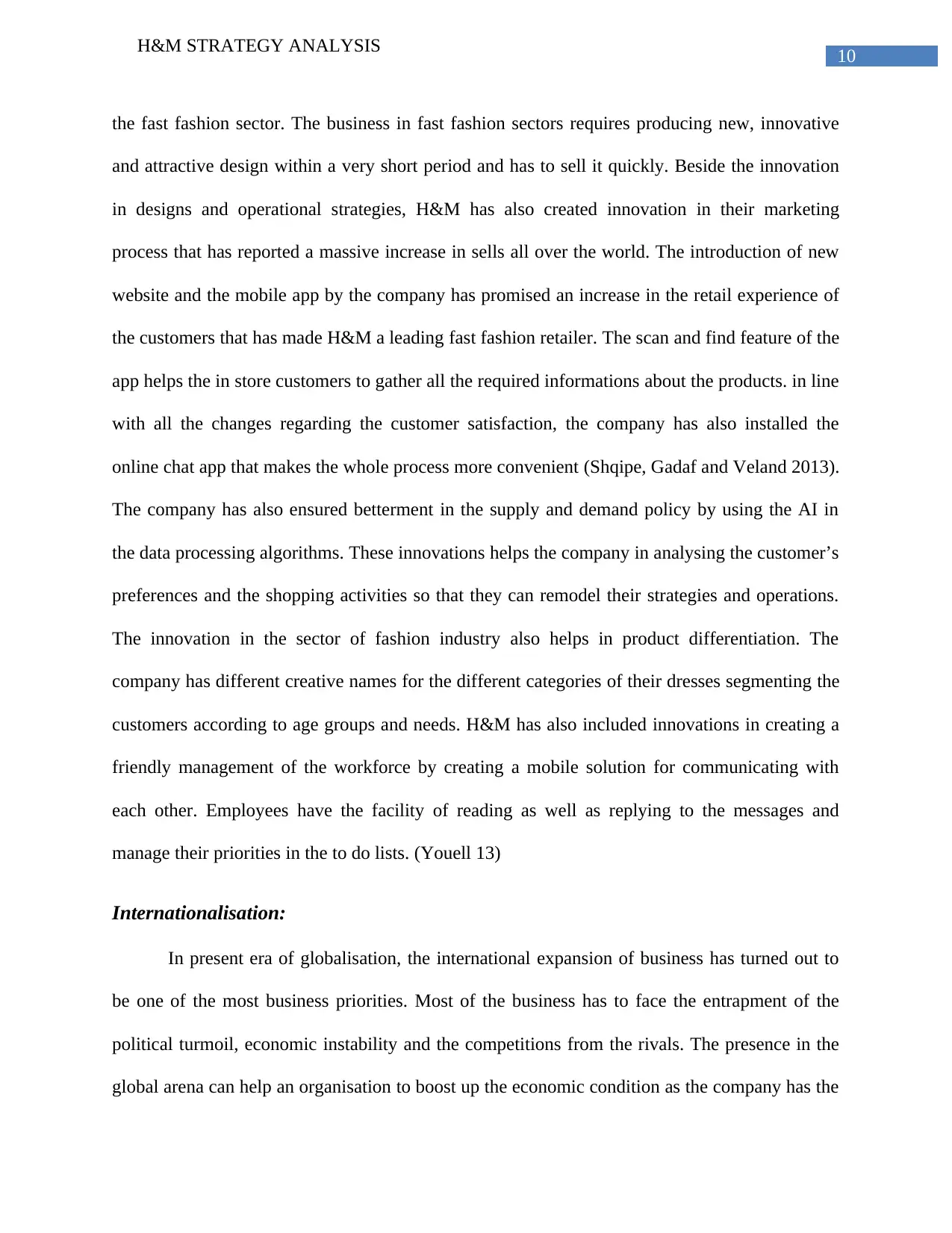
10
H&M STRATEGY ANALYSIS
the fast fashion sector. The business in fast fashion sectors requires producing new, innovative
and attractive design within a very short period and has to sell it quickly. Beside the innovation
in designs and operational strategies, H&M has also created innovation in their marketing
process that has reported a massive increase in sells all over the world. The introduction of new
website and the mobile app by the company has promised an increase in the retail experience of
the customers that has made H&M a leading fast fashion retailer. The scan and find feature of the
app helps the in store customers to gather all the required informations about the products. in line
with all the changes regarding the customer satisfaction, the company has also installed the
online chat app that makes the whole process more convenient (Shqipe, Gadaf and Veland 2013).
The company has also ensured betterment in the supply and demand policy by using the AI in
the data processing algorithms. These innovations helps the company in analysing the customer’s
preferences and the shopping activities so that they can remodel their strategies and operations.
The innovation in the sector of fashion industry also helps in product differentiation. The
company has different creative names for the different categories of their dresses segmenting the
customers according to age groups and needs. H&M has also included innovations in creating a
friendly management of the workforce by creating a mobile solution for communicating with
each other. Employees have the facility of reading as well as replying to the messages and
manage their priorities in the to do lists. (Youell 13)
Internationalisation:
In present era of globalisation, the international expansion of business has turned out to
be one of the most business priorities. Most of the business has to face the entrapment of the
political turmoil, economic instability and the competitions from the rivals. The presence in the
global arena can help an organisation to boost up the economic condition as the company has the
H&M STRATEGY ANALYSIS
the fast fashion sector. The business in fast fashion sectors requires producing new, innovative
and attractive design within a very short period and has to sell it quickly. Beside the innovation
in designs and operational strategies, H&M has also created innovation in their marketing
process that has reported a massive increase in sells all over the world. The introduction of new
website and the mobile app by the company has promised an increase in the retail experience of
the customers that has made H&M a leading fast fashion retailer. The scan and find feature of the
app helps the in store customers to gather all the required informations about the products. in line
with all the changes regarding the customer satisfaction, the company has also installed the
online chat app that makes the whole process more convenient (Shqipe, Gadaf and Veland 2013).
The company has also ensured betterment in the supply and demand policy by using the AI in
the data processing algorithms. These innovations helps the company in analysing the customer’s
preferences and the shopping activities so that they can remodel their strategies and operations.
The innovation in the sector of fashion industry also helps in product differentiation. The
company has different creative names for the different categories of their dresses segmenting the
customers according to age groups and needs. H&M has also included innovations in creating a
friendly management of the workforce by creating a mobile solution for communicating with
each other. Employees have the facility of reading as well as replying to the messages and
manage their priorities in the to do lists. (Youell 13)
Internationalisation:
In present era of globalisation, the international expansion of business has turned out to
be one of the most business priorities. Most of the business has to face the entrapment of the
political turmoil, economic instability and the competitions from the rivals. The presence in the
global arena can help an organisation to boost up the economic condition as the company has the
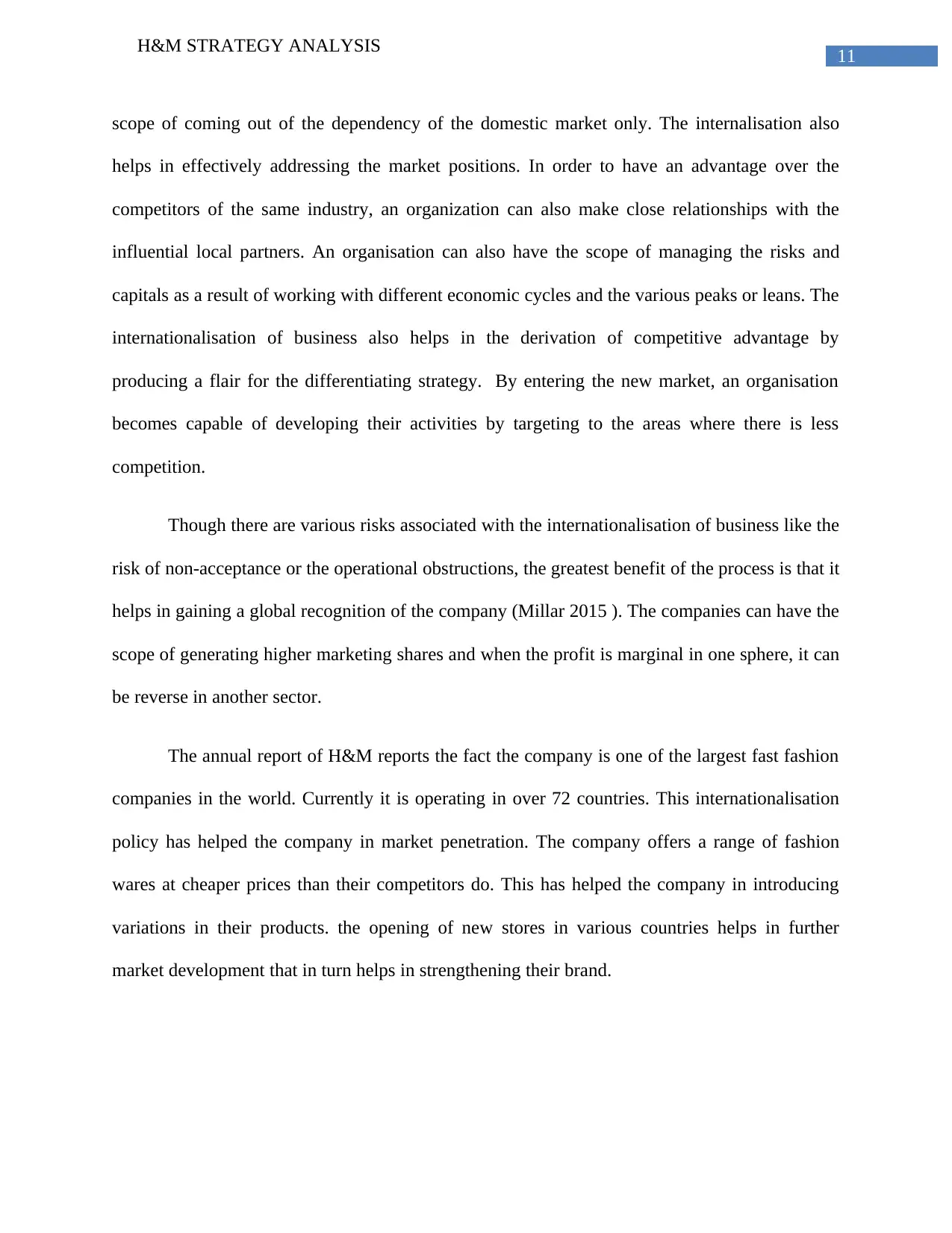
11
H&M STRATEGY ANALYSIS
scope of coming out of the dependency of the domestic market only. The internalisation also
helps in effectively addressing the market positions. In order to have an advantage over the
competitors of the same industry, an organization can also make close relationships with the
influential local partners. An organisation can also have the scope of managing the risks and
capitals as a result of working with different economic cycles and the various peaks or leans. The
internationalisation of business also helps in the derivation of competitive advantage by
producing a flair for the differentiating strategy. By entering the new market, an organisation
becomes capable of developing their activities by targeting to the areas where there is less
competition.
Though there are various risks associated with the internationalisation of business like the
risk of non-acceptance or the operational obstructions, the greatest benefit of the process is that it
helps in gaining a global recognition of the company (Millar 2015 ). The companies can have the
scope of generating higher marketing shares and when the profit is marginal in one sphere, it can
be reverse in another sector.
The annual report of H&M reports the fact the company is one of the largest fast fashion
companies in the world. Currently it is operating in over 72 countries. This internationalisation
policy has helped the company in market penetration. The company offers a range of fashion
wares at cheaper prices than their competitors do. This has helped the company in introducing
variations in their products. the opening of new stores in various countries helps in further
market development that in turn helps in strengthening their brand.
H&M STRATEGY ANALYSIS
scope of coming out of the dependency of the domestic market only. The internalisation also
helps in effectively addressing the market positions. In order to have an advantage over the
competitors of the same industry, an organization can also make close relationships with the
influential local partners. An organisation can also have the scope of managing the risks and
capitals as a result of working with different economic cycles and the various peaks or leans. The
internationalisation of business also helps in the derivation of competitive advantage by
producing a flair for the differentiating strategy. By entering the new market, an organisation
becomes capable of developing their activities by targeting to the areas where there is less
competition.
Though there are various risks associated with the internationalisation of business like the
risk of non-acceptance or the operational obstructions, the greatest benefit of the process is that it
helps in gaining a global recognition of the company (Millar 2015 ). The companies can have the
scope of generating higher marketing shares and when the profit is marginal in one sphere, it can
be reverse in another sector.
The annual report of H&M reports the fact the company is one of the largest fast fashion
companies in the world. Currently it is operating in over 72 countries. This internationalisation
policy has helped the company in market penetration. The company offers a range of fashion
wares at cheaper prices than their competitors do. This has helped the company in introducing
variations in their products. the opening of new stores in various countries helps in further
market development that in turn helps in strengthening their brand.
⊘ This is a preview!⊘
Do you want full access?
Subscribe today to unlock all pages.

Trusted by 1+ million students worldwide
1 out of 15
Related Documents
Your All-in-One AI-Powered Toolkit for Academic Success.
+13062052269
info@desklib.com
Available 24*7 on WhatsApp / Email
![[object Object]](/_next/static/media/star-bottom.7253800d.svg)
Unlock your academic potential
Copyright © 2020–2025 A2Z Services. All Rights Reserved. Developed and managed by ZUCOL.





